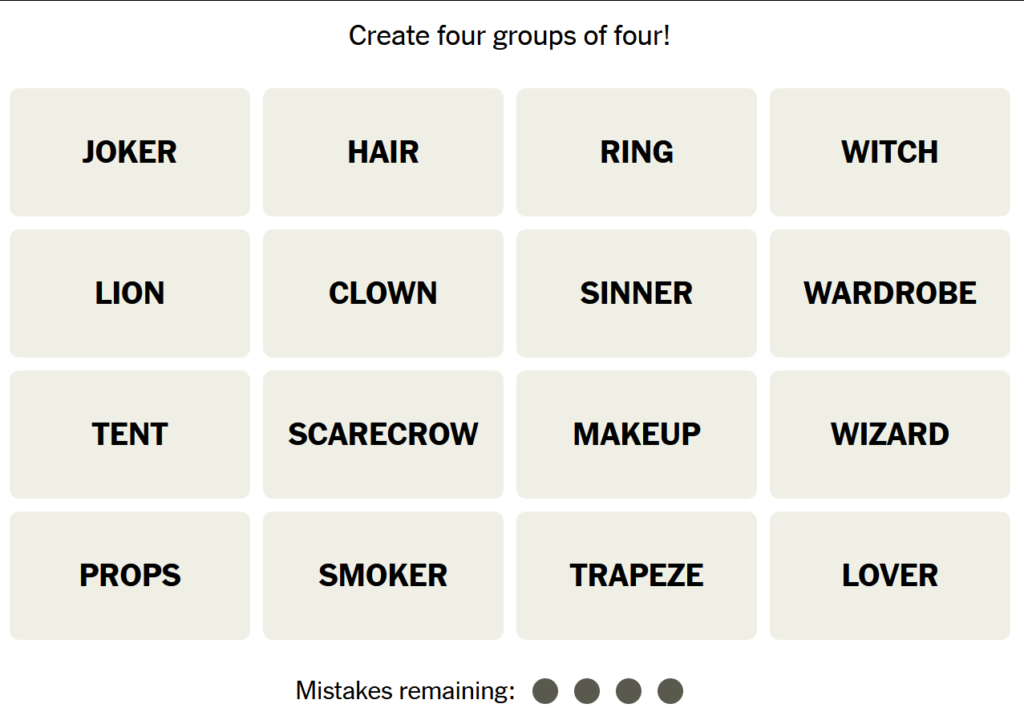The New York Times, long a hold-out against comic strips, nevertheless makes a concession to play and whimsy in the form of their Games page. A lot has been made about their purchase of Wordle (and their recent crackdown on imitators, boo), and it should not be construed that we appreciate that.
But we find that one of the more positive aspects of their gaming products lately has been their Connections puzzle, which right now is not even a year old. (I don’t know if you’ll need a subscription to get through to that link. Paywalls suck, but are a necessary suckage.)

Each puzzle is a 4×4 grid of words. Rarely it may contain phrases; on April 1st, it had emoji, but it’s usually pretty good about staying in its lingual lane. The positions of the words in the puzzle are not relevant to solving it, but they’re sometimes placed with an eye to theme, or in such a way to suggest connections that don’t actually exist, in order to obfuscate the solution a bit. Usually, they hardly need to bother; the puzzle is usually fairly difficult.
Each puzzle contains exactly four categories of four terms, no more and no less. The categories and words in the puzzle are always chosen to punish imprecise and vague associations.
A solver (I won’t presume that that solver will necessarily be you at this stage) will want to find four words that have the same relationship with their category. One will never have a subordinate relationship with another word in its category, exclamation point! I emphasize this because you’ll often find a puzzle has a word that seems to have a superior-inferior relationship with another word, but this is a trap! Categories are egalitarian! Down with hierarchy!
Words are also chosen so that sometimes you’ll only find three words in a prospective category, which is a sign that you’re on the wrong track. Sometimes you’ll find five, which could mean you’re on the wrong track, or that one of the words is slightly outside the category. Sometimes your only real clue is because another category relies on one of those words to complete it, instead: categories never overlap, so if a word is in one category it isn’t in another.
Because the categories are exclusive like this, if you find one category, all the other categories become a bit easier to figure out. There are always four, and they’re ranked, by the puzzle setter, in color by trickiness, from least to most crafty: yellow, green, blue and purple. If it helps you remember (let’s drop the pretense that you are not involved in this), those are in spectrum-order. Even so, often you’ll find you’ve gotten the blue or even purple category early.
You only get four failures, and the nature of the puzzle is that sometimes you’ll make a mistake or two. There is no penalty for running out of mistakes other than getting told the answers, which by that point is occasion to curse the perfidy of the puzzle maker. (“Brit-pop bands? How was I supposed to get that?”)
By way of aid, I can tell you that categories tend to follow certain themes. Sometimes they’re literal; sometimes ridiculously so. My (least) favorite example of this was CONDO – LOO – HAW – HERO. Go ahead. Guess what the hell those have to do with each other. You’ll hate it. (Answer at end of post.) But because, once you’ve gotten three categories, all that remains must be the fourth, you have some leeway, which is good for when you have a category like that one.
Another very common category is the phrase that’s completed by all the words in the category, or titles that are all completed by those words. If you’re stuck (yeah I’ve given in to just using second-person by this point), it’s often because there’s a category of this type.
Being well read is always useful for this kind of puzzle, but rarely is it necessary. Like the Crossword, a basic facility with language will be of inestimable aid. None of the connections will be too obscure; nor, likely, will you have to deal with absurd words like inestimable.
Unlike the Crossword, the New York Times doesn’t maintain a public archive of Connections puzzles for you to try, but multiple other sites do, at least until the NYT gets as litigiously jealous of them as they became of Wordle clones. Here is one. There is an official Companion blog that offers hints. Other sites, including Rock Paper Shotgun (really?), offer their own daily hints.
Here are some example categories, all taken from recent puzzles. What do these words have in common? I’ve hidden the answer with an abbr tag, on desktop devices you can hover the mouse over the words to reveal the category.
Star – Feather – Flower – Mushroom
Brain – Courage – Heart – Home
Jack – Love – Squat – Zip
Getting harder now:
Cradle – Eye – Meow – Pajamas
Dogs – Brown – Unchained – Fiction
Clown – King – Colonel – Mermaid
Bowl – Buzz – Crew – Pixie
Cigarette – Pencil – Ticket – Toe
And finally, that example I gave earlier:
Condo – Loo – Haw – Hero

Before the NYT thing there was Puzzgrid(.com), based on the British show Only Connect. It has user-submitted tableaus, it’s free, and they are quite the creative bunch over there. Best of all, they also let you guess the theme!